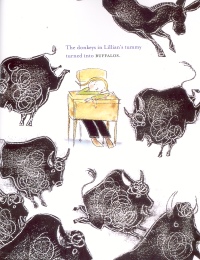| ________________
CM . . .
. Volume XIII Number 21 . . . . June 8, 2007
excerpt:
Reality is often scary when you are only seven-years-old, but a strong imagination may help buffer those fears. Lillian and her mother have had to move to a family shelter in another city for protection from Lillian’s abusive father. This new environment is different from Lillian’s old home, and Lillian has to go to a new school too. Lillian is uneasy and anxious with all these changes. She is placed in Grade Two with Ms. Garcia as her teacher. One daily activity in the Grade Two classroom is Show and Tell. When Lillian is told that her day to bring something for Show and Tell is Friday, she begins to feel nervous in her tummy. As the week passes, her classmates bring in their treasures to show: a doll that can talk, crawl and even pee; a brand new scooter; a model of a spaceship made from Lego; and a robotic pet that barked. Lillian’s tummy is really feeling the stress, and Coté, the illustrator, depicts a progression of intensity through analogies of a variety of animals scattered across the pages of the story: butterflies to grasshoppers to bunny rabbits and then to donkeys, and finally buffalo. And, on Friday, those same buffalo were running around in circles in Lillian’s stomach! Lillian’s mother suggests Lillian bring a toy from the shelter for Show and Tell. Lillian sadly remembers her father when the family was happy and all the toys she had to leave behind. Lillian doesn’t want to bring toys from the shelter; she wants to buy a new one. This is not possible because her mother is trying hard to save enough rent money so that Lillian and she can have their own place. Then further disappointment comes when Lillian cannot watch her favourite television show because the boy in the shelter is watching a show about cars. But, within a few days Lillian’s mother tells Lillian there will be enough money for them to move to their own place at the end of the month. Lillian has mixed feelings about this news.
Finally Friday arrives, and Lillian explains she does not have a toy to share with the class, but she does have magic beads for Show and Tell. Lillian lifts the plastic beads from around her neck and begins to tell the many ways she uses her beads: as a leash to walk her pet elephant; as a snake to eat the closet monster; as a magic wand; and as a tightrope for playing circus. Her classmates are mesmerized by Lillian’s imaginary stories, and a wonderful discussion follows about the many possibilities of the magic beads. These plastic beads become the link between Lillian and her new set of friends in the classroom. It is interesting to note that, although the beads are never mentioned until Lillian brings them for Show and Tell, Coté, throughout the book, has strategically included the beads with Lillian on each page. Abuse, family breakups, moving away, abandoning possessions, living in an unfamiliar location, loss of privacy, financial hardship, and new beginnings are the realities for many children today. This storybook, The Magic Beads, provides a context for discussion with youngsters about sensitive issues in a non-threatening way. Highly Recommended. Carolyn Crippen is the Assistant Dean of the Post Baccalaureate Diploma in Education (PBDE) in the Faculty of Education, the University of Manitoba.
To comment on this
title or this review, send mail to cm@umanitoba.ca.
Copyright © the Manitoba Library Association. Reproduction for personal
use is permitted only if this copyright notice is maintained. Any
other reproduction is prohibited without permission.
NEXT REVIEW |TABLE OF CONTENTS FOR THIS ISSUE
- June 8, 2007. AUTHORS
| TITLES | MEDIA REVIEWS
| PROFILES
| BACK ISSUES
| SEARCH | CMARCHIVE
| HOME |

